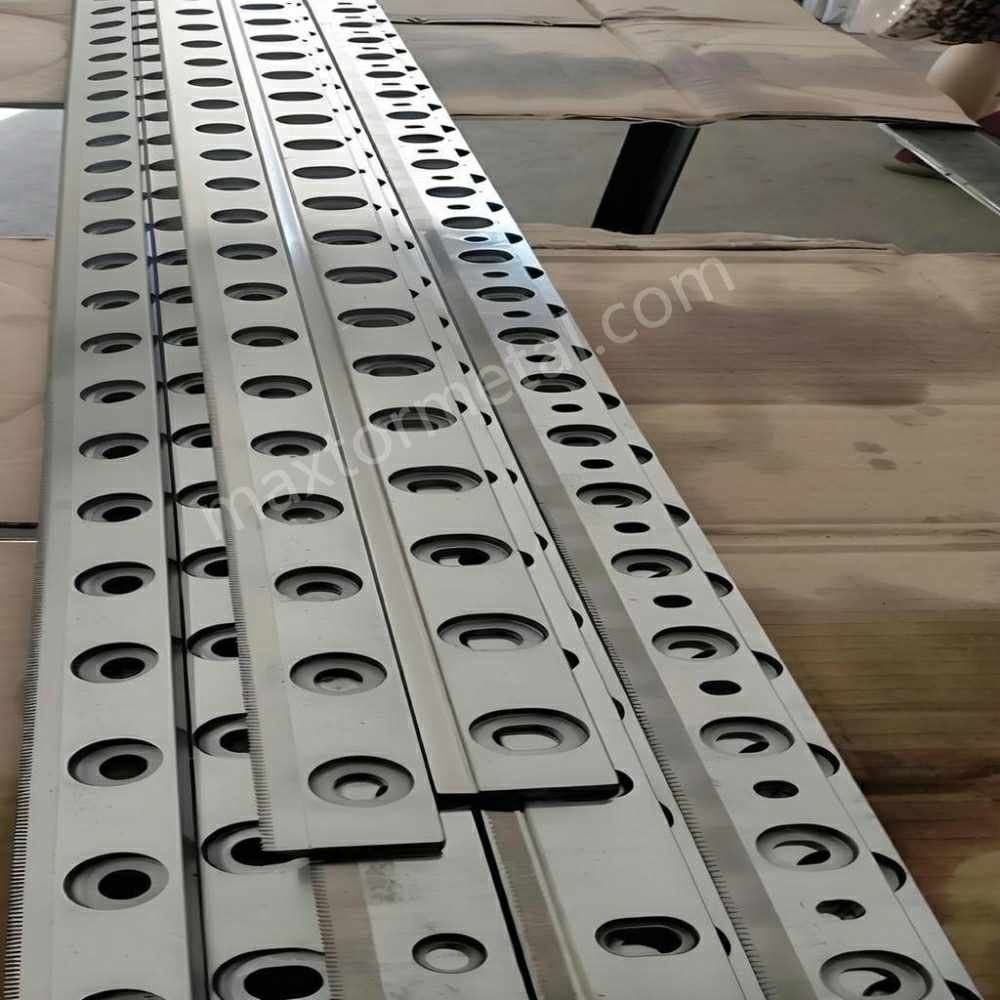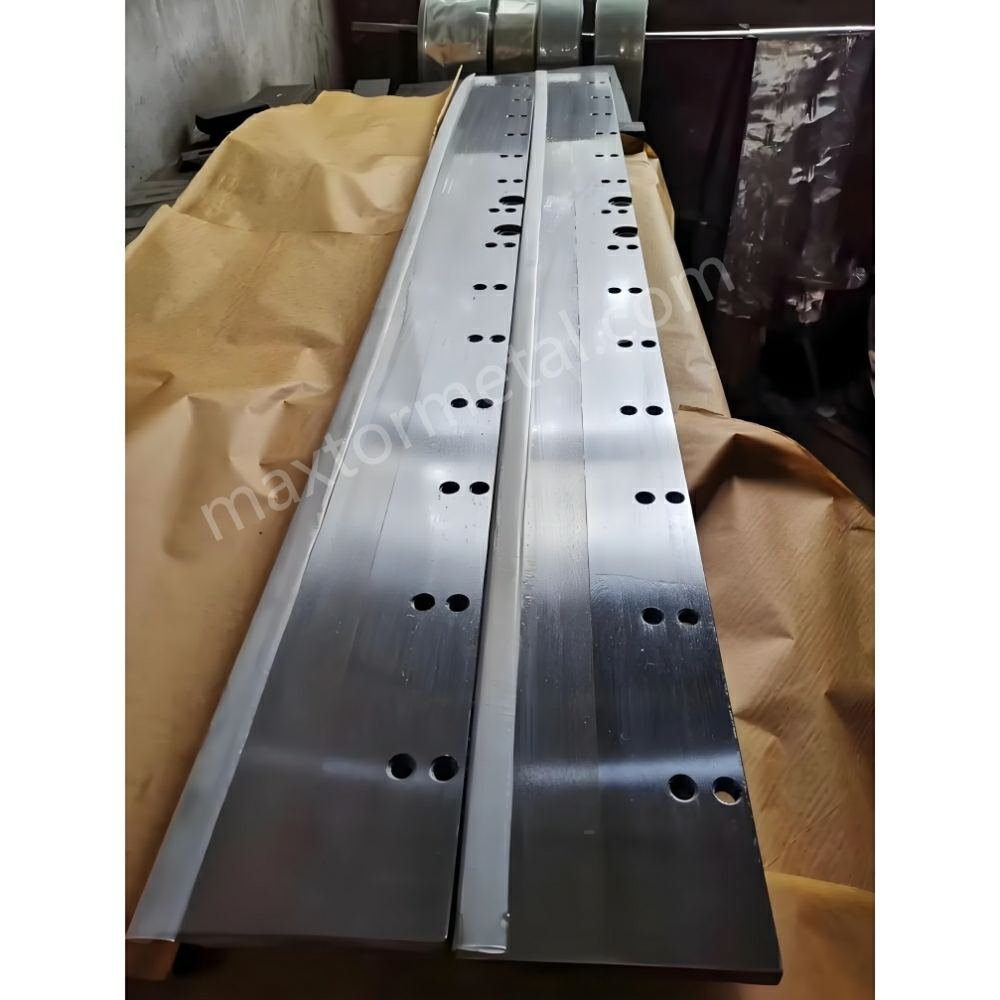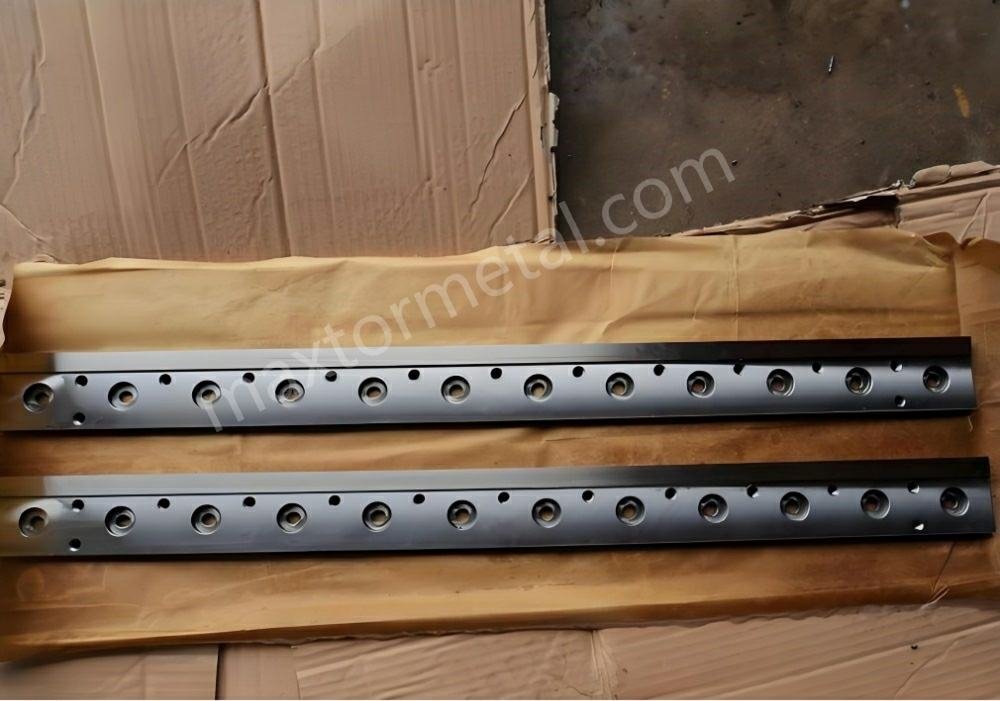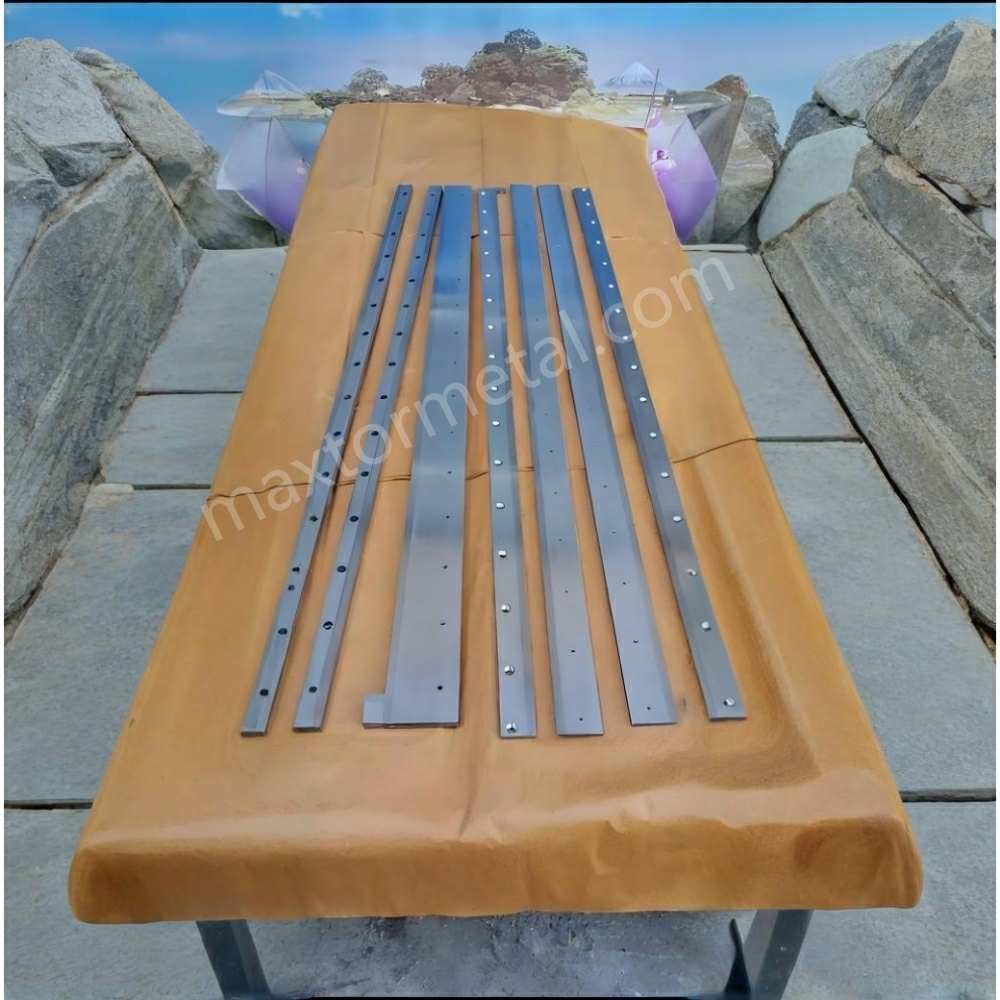Bản tóm tắt
Duy trì lưỡi cắt guillotine rất quan trọng để đạt được các đường cắt chính xác, kéo dài tuổi thọ của lưỡi dao và giảm thiểu thời gian chết của máy. Hướng dẫn này cung cấp các kỹ thuật chi tiết để vệ sinh, mài, bôi trơn và bảo quản, đồng thời giải quyết các lỗi bảo trì phổ biến. Hướng dẫn bao gồm các mẹo của chuyên gia, dữ liệu ngành và các giải pháp khả thi để tối ưu hóa hiệu suất của lưỡi dao và đảm bảo hiệu quả hoạt động.
Giới thiệu: Mở khóa bí mật về hiệu quả của lưỡi dao chém
Lưỡi cắt máy chém là những anh hùng thầm lặng trong các ngành công nghiệp như sản xuất, in ấn và gia công kim loại. Khả năng cắt sạch và chính xác của chúng khiến chúng trở nên không thể thiếu. Tuy nhiên, giống như bất kỳ công cụ hiệu suất cao nào, chúng cần được chăm sóc thường xuyên để hoạt động tối ưu.
Lưỡi dao bị bỏ quên dẫn đến chậm trễ sản xuất, tăng chi phí và rủi ro an toàn. Nghiên cứu cho thấy các công ty thực hiện bảo trì lưỡi dao chủ động giúp giảm chi phí thay thế lên đến 30% mỗi năm. Bài viết này cung cấp hướng dẫn từng bước để bảo trì lưỡi cắt guillotine, giải quyết các vấn đề như hao mòn, hư hỏng và kém hiệu quả.
1. Những điều cơ bản của Lưỡi cắt máy chém
1.1 Lưỡi cắt Guillotine là gì?
Những lưỡi dao này là dụng cụ công nghiệp được thiết kế để cắt chính xác nhiều loại vật liệu khác nhau, bao gồm:
- Metal: Tấm thép, nhôm và nhiều loại khác.
- Nhựa: Tấm polycarbonate hoặc acrylic.
- Giấy: Được sử dụng rộng rãi trong ngành in ấn và đóng gói.
Tính năng thiết kế:
- Lưỡi dao thẳng: Lý tưởng để cắt sạch và đồng đều.
- Lưỡi dao vát cạnh: Hiệu quả khi cắt những vật liệu dày hơn.
- Vật liệu sử dụng: Thường được làm bằng thép cứng hoặc cacbua vonfram, được lựa chọn vì độ bền và khả năng chống mài mòn.
Để hiểu sâu hơn về lưỡi cắt guillotine, khám phá điều này hướng dẫn toàn diện về bảo dưỡng dao công nghiệp.

1.2 Tại sao bảo trì đúng cách là điều cần thiết
Các nghiên cứu trong ngành chỉ ra rằng lưỡi dao cùn có thể làm tăng lãng phí vật liệu lên 20% và thời gian ngừng máy lên 15%. Bảo trì đảm bảo:
- Độ chính xác cắt đồng đều.
- Giảm chi phí vận hành bằng cách tránh thay thế sớm.
- Tăng cường an toàn cho người vận hành máy.
Mẹo nhanh:Kiểm tra thường xuyên có thể xác định các vấn đề nhỏ trước khi chúng trở nên nghiêm trọng hơn, giúp bạn tiết kiệm cả thời gian và tiền bạc.
2. Xác định nhu cầu bảo trì
2.1 Nhận biết dấu hiệu hao mòn
Biết khi nào lưỡi dao cần được chăm sóc có thể ngăn ngừa sự cố tốn kém. Hãy tìm:
- Thiệt hại bề mặt: Có vết nứt hoặc mẻ ở mép lưỡi dao.
- Ăn mòn: Các vết gỉ sét làm suy yếu tính toàn vẹn của kết cấu.
- Hiệu suất suy giảm: Các vết cắt không đều hoặc không chính xác.
| Triệu chứng | Vấn đề tiềm ẩn |
| Các gờ trên vật liệu cắt | Lưỡi dao cùn |
| Hoạt động ồn ào | Lưỡi dao không thẳng hàng hoặc bị mòn ở các cạnh |
| Nhiệt lượng sinh ra quá mức | Thiếu bôi trơn |
2.2 Hiểu nguyên nhân gây hư hỏng lưỡi dao
Bảo trì phòng ngừa bắt đầu bằng việc giải quyết nguyên nhân gốc rễ:
- Sử dụng vật liệu không đúng cách:Cắt vật liệu quá dày hoặc quá đặc sẽ làm tăng tốc độ mài mòn.
- Thực hành vệ sinh kém: Sử dụng chất tẩy rửa có tính mài mòn sẽ làm xước bề mặt lưỡi dao.
- Bôi trơn không đủ: Dẫn đến quá nhiệt và tăng ma sát.
Mẹo chuyên nghiệp: Ghi lại số giờ sử dụng lưỡi dao để dự đoán thời điểm cần bảo trì hoặc thay thế.

3. Thực hành tốt nhất để bảo dưỡng lưỡi cắt máy chém
3.1 Vệ sinh lưỡi dao đúng cách
Vệ sinh thường xuyên là nền tảng của việc chăm sóc lưỡi dao. Thực hiện theo các bước sau:
- Loại bỏ mảnh vụn: Sử dụng khí nén hoặc bàn chải mềm.
- Áp dụng chất làm sạch lưỡi dao: Chọn dung dịch không ăn mòn, có độ pH trung tính.
- Rửa sạch và lau khô kỹ lưỡng:Tránh để lưỡi dao tiếp xúc với hơi ẩm để tránh bị gỉ sét.
| Nên làm | Không nên |
| Sử dụng vải sợi nhỏ | Sử dụng bàn chải thép |
| Sử dụng chất tẩy rửa gốc dầu | Chỉ sử dụng dung dịch gốc nước |
3.2 Kỹ thuật mài
Mài đúng cách sẽ phục hồi hiệu suất cắt và kéo dài tuổi thọ của lưỡi dao.
- Khi nào cần mài: Sau 50–70 giờ cắt hoặc khi xuất hiện gờ vật liệu.
- Công cụ sử dụng: Máy mài, đá mài hoặc hệ thống mài kim cương.
- Kỹ thuật: Duy trì góc vát ban đầu (thường là 17–22 độ).
Thống kê: Lưỡi dao được mài sắc giúp tăng tốc độ cắt lên tới 15%.
3.3 Bôi trơn: Thiết yếu cho tuổi thọ
Bôi trơn làm giảm ma sát và ngăn ngừa quá nhiệt. Sử dụng:
- Dầu hiệu suất cao: Được thiết kế cho các công cụ công nghiệp.
- Tần suất ứng dụng: Sau mỗi lần vệ sinh hoặc sau mỗi 20 giờ sử dụng.
Nhấp vào đây để tìm hiểu cách chọn chất bôi trơn phù hợp.
3.4 Kỹ thuật lưu trữ thích hợp
Lưu trữ lưỡi cắt guillotine giảm thiểu rủi ro hư hỏng một cách an toàn.
- Sử dụng vỏ bảo vệ: Để che chắn các cạnh.
- Giữ trong môi trường khô ráo:Độ ẩm cao gây ra rỉ sét.
- Tránh chồng lưỡi dao: Bảo quản riêng lẻ hoặc trong ngăn chia có đệm.

4. Những lỗi bảo trì thường gặp cần tránh
4.1 Bỏ qua các cuộc kiểm tra theo lịch trình
Việc kiểm tra thường xuyên là không thể thương lượng. Việc bỏ qua chúng sẽ dẫn đến:
- Các vấn đề về hao mòn hoặc căn chỉnh không được phát hiện.
- Chi phí tăng do hỏng hóc đột ngột.
4.2 Sử dụng công cụ hoặc chất tẩy rửa không đúng cách
Tránh sử dụng các công cụ mài mòn và chất tẩy rửa có tính axit vì:
- Cào bề mặt lưỡi dao.
- Loại bỏ lớp phủ bảo vệ.
4.3 Bỏ qua các giao thức an toàn
Khi sử dụng lưỡi dao sắc, hãy luôn:
- Đeo găng tay và kính bảo hộ.
- Cố định lưỡi dao vào giá đỡ chắc chắn trước khi vệ sinh hoặc mài.
5. Biết khi nào cần thay thế máy cắt Guillotine của bạn lưỡi dao
5.1 Các chỉ số cho thấy việc bảo trì không còn đủ nữa
Một số vấn đề cần phải thay lưỡi dao ngay lập tức:
- Thiệt hại không thể khắc phục: Các vết nứt sâu hoặc cong vênh.
- Các vấn đề về hiệu suất liên tục: Các vết cắt vẫn không đều ngay cả sau khi mài.
5.2 Cách chọn lưỡi dao thay thế
Khi mua lưỡi dao mới:
- Kiểm tra khả năng tương thích: Đảm bảo chúng phù hợp với mẫu máy chém của bạn.
- Lựa chọn vật liệu chất lượng cao: Cacbua vonfram có độ bền cao hơn thép tiêu chuẩn tới 2,5 lần.

6. Lời khuyên của chuyên gia để kéo dài tuổi thọ của lưỡi dao
6.1 Đào tạo người vận hành
Đào tạo người vận hành cách xử lý lưỡi dao đúng cách, chẳng hạn như:
- Cắt trong giới hạn độ dày vật liệu được chỉ định.
- Báo cáo thường xuyên các dấu hiệu hao mòn hoặc hư hỏng.
6.2 Hợp tác với các chuyên gia
Kiểm tra định kỳ bởi các chuyên gia đảm bảo đánh giá toàn diện. Mài chuyên nghiệp cũng:
- Giữ nguyên hình dạng ban đầu của lưỡi dao.
- Tăng cường độ đồng nhất khi cắt.
7. Câu hỏi thường gặp
Câu hỏi 1: Tôi nên vệ sinh máy tính của mình thường xuyên như thế nào? lưỡi cắt guillotine?
Bạn nên vệ sinh lưỡi dao sau mỗi 8–10 giờ hoạt động hoặc sau khi cắt những vật liệu đặc biệt bẩn.
Câu hỏi 2: Cách tốt nhất để bảo quản lưỡi cắt guillotine là gì?
Bảo quản lưỡi dao ở nơi khô ráo, thoáng mát, có nắp bảo vệ để tránh gỉ sét và hư hỏng.
Câu hỏi 3: Tôi có thể mài lưỡi dao ở nhà không?
Có, nhưng bạn phải sử dụng đúng công cụ và duy trì góc vát chính xác. Đối với việc mài phức tạp, hãy cân nhắc đến các dịch vụ chuyên nghiệp.
Câu hỏi 4: Lưỡi cắt guillotine thường có tuổi thọ bao lâu?
Với việc bảo dưỡng đúng cách, lưỡi dao chất lượng cao có thể sử dụng được từ 6–12 tháng khi sử dụng nhiều hoặc lâu hơn khi sử dụng vừa phải.
Kết luận: Đối tác của bạn trong việc bảo trì lưỡi dao
Chăm sóc cho bạn lưỡi cắt guillotine không chỉ là một thói quen—mà là một khoản đầu tư thông minh vào hiệu quả và an toàn. Bằng cách làm theo những mẹo này, bạn có thể tiết kiệm chi phí, nâng cao hiệu suất và kéo dài tuổi thọ của lưỡi dao.
Bạn đã sẵn sàng tối ưu hóa lưỡi dao của mình chưa? Liên hệ chúng tôi hôm nay để được bảo trì dịch vụ hoặc khám phá KIM LOẠI Dòng lưỡi dao thay thế cao cấp.



4 bình luận
Tôi thực sự lấy cảm hứng từ tài năng viết lách của bạn và cả cấu trúc trên blog của bạn. Đây có phải là chủ đề trả phí hay bạn tự tùy chỉnh không? Dù bằng cách nào, hãy tiếp tục viết bài chất lượng cao tuyệt vời, thật hiếm khi thấy một blog hay như thế này trong thời buổi ngày nay.
Cảm ơn sự ghi nhận của bạn. Tất cả đều được chúng tôi tóm tắt dựa trên các chủ đề mà khách hàng của chúng tôi yêu cầu, kết hợp với khả năng tiếp cận thông tin và kinh nghiệm của chúng tôi trong ngành công nghiệp lưỡi dao công nghiệp.
Nếu bạn có nhu cầu tùy chỉnh lưỡi dao công nghiệp, vui lòng liên hệ với chúng tôi.
Tôi thực sự lấy cảm hứng từ khả năng viết của bạn và cũng với
cấu trúc trong blog của bạn. Dù bằng cách nào, hãy tiếp tục viết những bài viết chất lượng cao tuyệt vời,
thật hiếm khi thấy một blog hay như thế này ngày nay.
Cảm ơn!